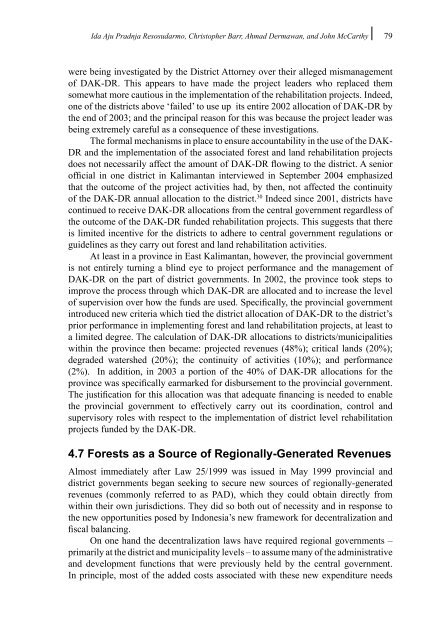Decentralization of Forest Administration in Indonesia, Implications ...
Decentralization of Forest Administration in Indonesia, Implications ...
Decentralization of Forest Administration in Indonesia, Implications ...
You also want an ePaper? Increase the reach of your titles
YUMPU automatically turns print PDFs into web optimized ePapers that Google loves.
Ida Aju Pradnja Resosudarmo, Christopher Barr, Ahmad Dermawan, and John McCarthy 79<br />
were be<strong>in</strong>g <strong>in</strong>vestigated by the District Attorney over their alleged mismanagement<br />
<strong>of</strong> DAK-DR. This appears to have made the project leaders who replaced them<br />
somewhat more cautious <strong>in</strong> the implementation <strong>of</strong> the rehabilitation projects. Indeed,<br />
one <strong>of</strong> the districts above ‘failed’ to use up its entire 2002 allocation <strong>of</strong> DAK-DR by<br />
the end <strong>of</strong> 2003; and the pr<strong>in</strong>cipal reason for this was because the project leader was<br />
be<strong>in</strong>g extremely careful as a consequence <strong>of</strong> these <strong>in</strong>vestigations.<br />
The formal mechanisms <strong>in</strong> place to ensure accountability <strong>in</strong> the use <strong>of</strong> the DAK-<br />
DR and the implementation <strong>of</strong> the associated forest and land rehabilitation projects<br />
does not necessarily affect the amount <strong>of</strong> DAK-DR flow<strong>in</strong>g to the district. A senior<br />
<strong>of</strong>ficial <strong>in</strong> one district <strong>in</strong> Kalimantan <strong>in</strong>terviewed <strong>in</strong> September 2004 emphasized<br />
that the outcome <strong>of</strong> the project activities had, by then, not affected the cont<strong>in</strong>uity<br />
<strong>of</strong> the DAK-DR annual allocation to the district. 30 Indeed s<strong>in</strong>ce 2001, districts have<br />
cont<strong>in</strong>ued to receive DAK-DR allocations from the central government regardless <strong>of</strong><br />
the outcome <strong>of</strong> the DAK-DR funded rehabilitation projects. This suggests that there<br />
is limited <strong>in</strong>centive for the districts to adhere to central government regulations or<br />
guidel<strong>in</strong>es as they carry out forest and land rehabilitation activities.<br />
At least <strong>in</strong> a prov<strong>in</strong>ce <strong>in</strong> East Kalimantan, however, the prov<strong>in</strong>cial government<br />
is not entirely turn<strong>in</strong>g a bl<strong>in</strong>d eye to project performance and the management <strong>of</strong><br />
DAK-DR on the part <strong>of</strong> district governments. In 2002, the prov<strong>in</strong>ce took steps to<br />
improve the process through which DAK-DR are allocated and to <strong>in</strong>crease the level<br />
<strong>of</strong> supervision over how the funds are used. Specifically, the prov<strong>in</strong>cial government<br />
<strong>in</strong>troduced new criteria which tied the district allocation <strong>of</strong> DAK-DR to the district’s<br />
prior performance <strong>in</strong> implement<strong>in</strong>g forest and land rehabilitation projects, at least to<br />
a limited degree. The calculation <strong>of</strong> DAK-DR allocations to districts/municipalities<br />
with<strong>in</strong> the prov<strong>in</strong>ce then became: projected revenues (48%); critical lands (20%);<br />
degraded watershed (20%); the cont<strong>in</strong>uity <strong>of</strong> activities (10%); and performance<br />
(2%). In addition, <strong>in</strong> 2003 a portion <strong>of</strong> the 40% <strong>of</strong> DAK-DR allocations for the<br />
prov<strong>in</strong>ce was specifically earmarked for disbursement to the prov<strong>in</strong>cial government.<br />
The justification for this allocation was that adequate f<strong>in</strong>anc<strong>in</strong>g is needed to enable<br />
the prov<strong>in</strong>cial government to effectively carry out its coord<strong>in</strong>ation, control and<br />
supervisory roles with respect to the implementation <strong>of</strong> district level rehabilitation<br />
projects funded by the DAK-DR.<br />
4.7 <strong>Forest</strong>s as a Source <strong>of</strong> Regionally-Generated Revenues<br />
Almost immediately after Law 25/1999 was issued <strong>in</strong> May 1999 prov<strong>in</strong>cial and<br />
district governments began seek<strong>in</strong>g to secure new sources <strong>of</strong> regionally-generated<br />
revenues (commonly referred to as PAD), which they could obta<strong>in</strong> directly from<br />
with<strong>in</strong> their own jurisdictions. They did so both out <strong>of</strong> necessity and <strong>in</strong> response to<br />
the new opportunities posed by <strong>Indonesia</strong>’s new framework for decentralization and<br />
fiscal balanc<strong>in</strong>g.<br />
On one hand the decentralization laws have required regional governments –<br />
primarily at the district and municipality levels – to assume many <strong>of</strong> the adm<strong>in</strong>istrative<br />
and development functions that were previously held by the central government.<br />
In pr<strong>in</strong>ciple, most <strong>of</strong> the added costs associated with these new expenditure needs

















